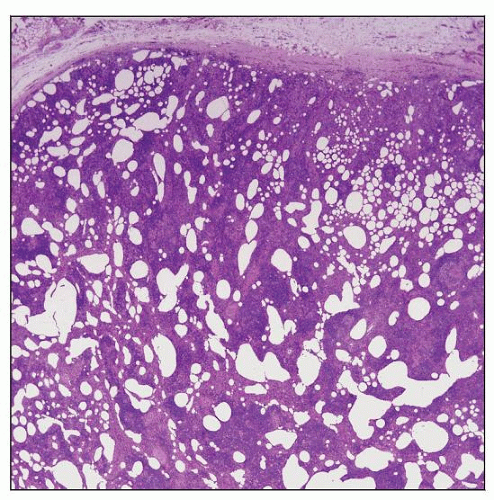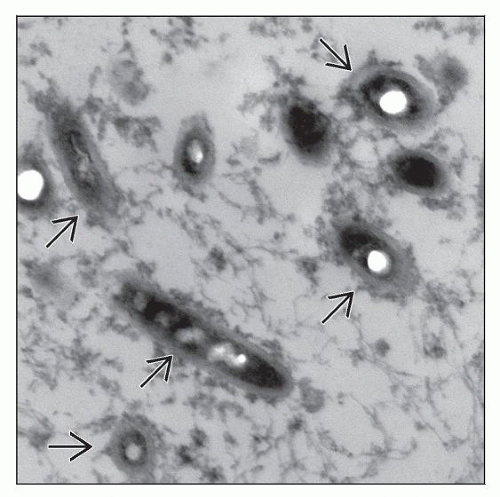Whipple Disease
Sa A. Wang, MD
Key Facts
Etiology/Pathogenesis
T. whipplei, gram-positive bacilli related to Actinomycetes
Engulfed by tissue macrophages
Systemic disease; affects many organ systems
Exerts no visible cytotoxic effects upon host cells
Human host shows remarkable lack of inflammatory response to bacilli
Clinical Issues
Whipple disease is extremely rare, incidence ˜ 30 cases per year
Affects predominantly middle-aged white men
Farmers and people with occupational exposure to soil or animals have highest incidence
Laboratory testing: PCR using primers common to DNA encoding unique bacterial 16S ribosomal RNA is standard test
Treatment: General recommendation is intravenous ceftriaxone x 2 weeks
Followed by oral co-trimoxazole or oral trimethoprim-sulfamethoxazole x 1-2 years
Microscopic Pathology
Histiocytes/macrophages containing undigested bacteria or remnants of bacterial wall
DPAS(+), acid-fast(-), specific antibody to T. whipplei can be used for immunohistochemistry
Top Differential Diagnoses
Lysosomal storage disorders, mycobacterial infection, malabsorption syndrome
 Whipple disease involving mesenteric lymph node. The nodal architecture is obscured by ill-defined lipogranulomas and cystic spaces. |
TERMINOLOGY
Synonyms
Intestinal lipodystrophy
Definitions
Systemic disease caused by Tropheryma whipplei infection
ETIOLOGY/PATHOGENESIS
Infectious Agents
T. whipplei, gram-positive bacilli related to Actinomycetes
Found primarily in soil and sewage but not in animal hosts
T. whipplei are intracellular organisms
Primarily engulfed by and reside within tissue macrophages
Can also reside within intestinal epithelial cells and endothelial cells
Organism exerts no visible cytotoxic effects upon host cells
T. whipplei: Systemic infection can affect many organs
Host Immune Deficiency Likely Involved in Pathogenesis
Possibly, immune downregulation is induced by bacterium
Human host shows remarkable lack of inflammatory response to bacilli
Massive accumulation of T. whipplei at sites of infection
CLINICAL ISSUES
Epidemiology
Incidence
Whipple disease is extremely rare
˜ 1,500 cases reported in literature
Incidence of ˜ 30 cases per year
Farmers and persons with occupational exposure to soil or animals have highest incidence
Humans remain only known host for disease
No evidence exists of person-to-person transmission
No outbreaks have been reported
Age
Middle-aged and elderly persons; mean age: 40 years
Gender
M:F = ˜ 8-9:1
Ethnicity
North America and Western Europe
Presentation
Arthralgias, often migratory
Large joints more often affected than small joints
Rheumatoid factor negative
Can precede gastrointestinal symptoms
Weight loss
Diarrhea, steatorrhea, abdominal pain
Central nervous system (CNS) disease
Cognitive dysfunction and dementia
Oculomasticatory or oculo-facial-skeletal myorhythmia
Stay updated, free articles. Join our Telegram channel

Full access? Get Clinical Tree




